使用 Assembly 打包和部署 Spring Boot 工程
- 2023-03-14 湖南
本文字数:8455 字
阅读完需:约 28 分钟
Spring Boot 项目的 2 种部署方式
目前来说,Spring Boot 项目有如下 2 种常见的部署方式
一种是使用 docker 容器去部署。将 Spring Boot 的应用构建成一个 docker image,然后通过容器去启动镜像。这种方式在需要部署大规模的应用以及对应用进行扩展时,是非常方便的,属于目前工业级的部署方案,但是需要掌握 docker 的生态圈技术。
另一种则是使用 FatJar 直接部署启动(将一个 jar 及其依赖的三方 jar 全部打到一个包中,这个包即为 FatJar)。这是很多初学者或者极小规模情况下的一个简单应用部署方式。
Assembly 的优势
上面介绍的 Fatjar 部署方案存在一些缺陷。因为我们如果直接构建一个 Spring Boot 的 FatJar 交由运维人员部署的话,整个配置文件都被隐藏到 jar 中,想要针对不同的环境修改配置文件就变成了一件很困难的事情。如果存在环境不确定,或者需要启动脚本启动项目的时候,这种直接通过 jar 的方式后续会需要处理很多工作。
而通过 assembly 将 Spring Boot 服务化打包,便能解决上面提到的 2 个问题
使得 Spring Boot 能够加载 jar 外的配置文件。
提供一个服务化的启动脚本,这个脚本一般是 shell 或者 windows 下的 bat ,有了 Spring Boot 的应用服务脚本后,就可以很容易的去启动和停止 Spring Boot 的应用了。
项目配置
添加插件
(1) 编辑项目的 pom.xml 文件,加入 assembly 打包插件。
<build> <plugins> <plugin> <groupId>org.springframework.boot</groupId> <artifactId>spring-boot-maven-plugin</artifactId> </plugin> <plugin> <!--主要使用的是maven提供的assembly插件完成--> <artifactId>maven-assembly-plugin</artifactId> <version>3.1.1</version> <configuration> <descriptors> <!--具体的配置文件--> <descriptor>src/main/assembly/assembly.xml</descriptor> </descriptors> </configuration> <executions> <execution> <id>make-assembly</id> <!--绑定到maven操作类型上--> <phase>package</phase> <!--运行一次--> <goals> <goal>single</goal> </goals> </execution> </executions> </plugin> </plugins></build>(2) 从上面代码可以看出,把 assembly 的配置都放在 main/assembly 目录下(具体目录里面的文件接下来会创建)。
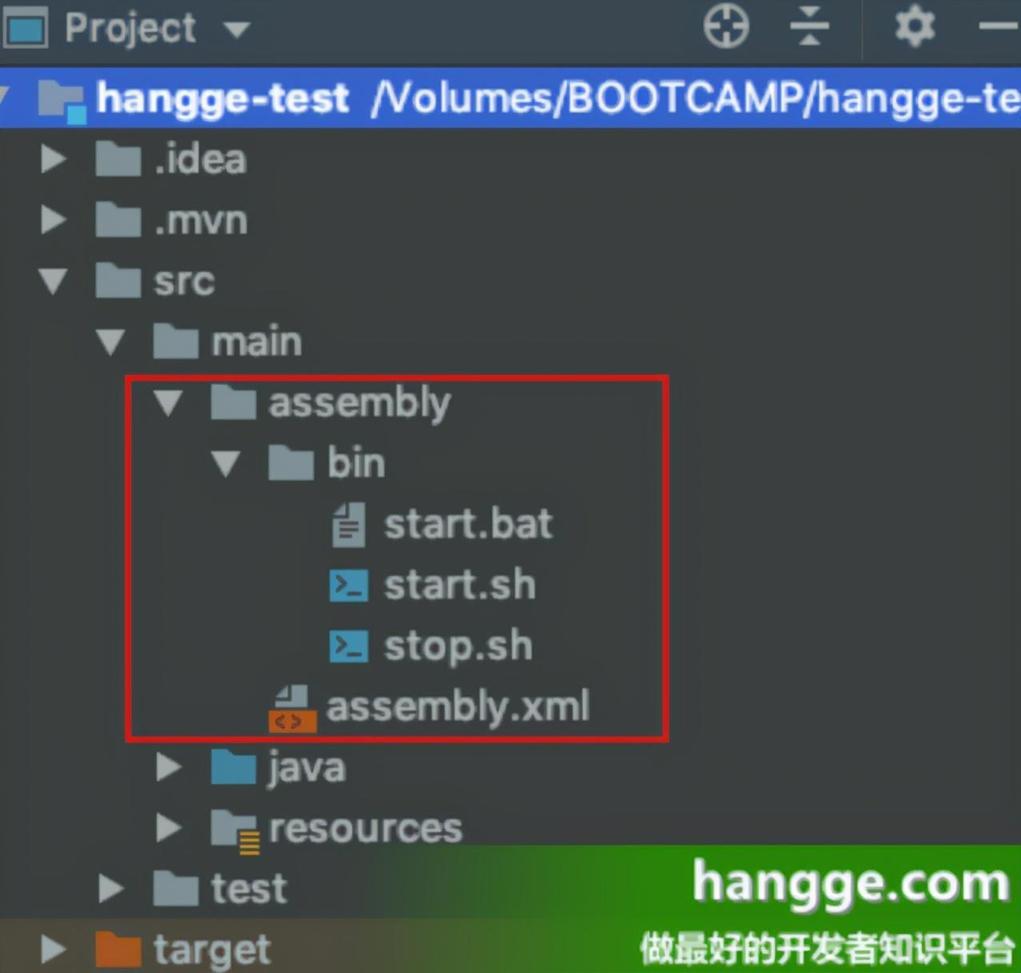
编写服务启动/停止脚本
首先在 assembly 目录下创建一个 bin 文件夹,然后在该文件夹下创建一个 start.sh 文件,这个是 linux 环境下的启动脚本,具体内容如下:
Tip:开头的项目名称、jar 包名称不用我们手动设置,这里使用参数变量,在项目打包后这些参数自动会替换为 pom 的 profiles 中 properties 的值(assembly 配置文件需要开启属性替换功能),下面另外两个配置文件也同理。
#!/bin/bash
# 项目名称SERVER_NAME="${project.artifactId}"
# jar名称JAR_NAME="${project.build.finalName}.jar"
# 进入bin目录cd `dirname $0`# bin目录绝对路径BIN_DIR=`pwd`# 返回到上一级项目根目录路径cd ..# 打印项目根目录绝对路径# `pwd` 执行系统命令并获得结果DEPLOY_DIR=`pwd`
# 外部配置文件绝对目录,如果是目录需要/结尾,也可以直接指定文件# 如果指定的是目录,spring则会读取目录中的所有配置文件CONF_DIR=$DEPLOY_DIR/config# SERVER_PORT=`sed '/server.port/!d;s/.*=//' config/application.properties | tr -d '\r'`# 获取应用的端口号SERVER_PORT=`sed -nr '/port: [0-9]+/ s/.*port: +([0-9]+).*/\1/p' config/application.yml`
PIDS=`ps -f | grep java | grep "$CONF_DIR" |awk '{print $2}'`if [ "$1" = "status" ]; then if [ -n "$PIDS" ]; then echo "The $SERVER_NAME is running...!" echo "PID: $PIDS" exit 0 else echo "The $SERVER_NAME is stopped" exit 0 fifi
if [ -n "$PIDS" ]; then echo "ERROR: The $SERVER_NAME already started!" echo "PID: $PIDS" exit 1fi
if [ -n "$SERVER_PORT" ]; then SERVER_PORT_COUNT=`netstat -tln | grep $SERVER_PORT | wc -l` if [ $SERVER_PORT_COUNT -gt 0 ]; then echo "ERROR: The $SERVER_NAME port $SERVER_PORT already used!" exit 1 fifi
# 项目日志输出绝对路径LOGS_DIR=$DEPLOY_DIR/logs# 如果logs文件夹不存在,则创建文件夹if [ ! -d $LOGS_DIR ]; then mkdir $LOGS_DIRfiSTDOUT_FILE=$LOGS_DIR/catalina.log
# JVM ConfigurationJAVA_OPTS=" -Djava.awt.headless=true -Djava.net.preferIPv4Stack=true "JAVA_DEBUG_OPTS=""if [ "$1" = "debug" ]; then JAVA_DEBUG_OPTS=" -Xdebug -Xnoagent -Djava.compiler=NONE -Xrunjdwp:transport=dt_socket,address=8000,server=y,suspend=n "fi
JAVA_JMX_OPTS=""if [ "$1" = "jmx" ]; then JAVA_JMX_OPTS=" -Dcom.sun.management.jmxremote.port=1099 -Dcom.sun.management.jmxremote.ssl=false -Dcom.sun.management.jmxremote.authenticate=false "fi
JAVA_MEM_OPTS=""BITS=`java -version 2>&1 | grep -i 64-bit`if [ -n "$BITS" ]; then JAVA_MEM_OPTS=" -server -Xmx512m -Xms512m -Xmn256m -XX:PermSize=128m -Xss256k -XX:+DisableExplicitGC -XX:+UseConcMarkSweepGC -XX:+CMSParallelRemarkEnabled -XX:+UseCMSCompactAtFullCollection -XX:LargePageSizeInBytes=128m -XX:+UseFastAccessorMethods -XX:+UseCMSInitiatingOccupancyOnly -XX:CMSInitiatingOccupancyFraction=70 "else JAVA_MEM_OPTS=" -server -Xms512m -Xmx512m -XX:PermSize=128m -XX:SurvivorRatio=2 -XX:+UseParallelGC "fi
# 加载外部log4j2文件的配置LOG_IMPL_FILE=log4j2.xmlLOGGING_CONFIG=""if [ -f "$CONF_DIR/$LOG_IMPL_FILE" ]then LOGGING_CONFIG="-Dlogging.config=$CONF_DIR/$LOG_IMPL_FILE"fiCONFIG_FILES=" -Dlogging.path=$LOGS_DIR $LOGGING_CONFIG -Dspring.config.location=$CONF_DIR/ "echo -e "Starting the $SERVER_NAME ..."nohup java $JAVA_OPTS $JAVA_MEM_OPTS $JAVA_DEBUG_OPTS $JAVA_JMX_OPTS $CONFIG_FILES -jar $DEPLOY_DIR/lib/$JAR_NAME > $STDOUT_FILE 2>&1 &
COUNT=0while [ $COUNT -lt 1 ]; do echo -e ".\c" sleep 1 if [ -n "$SERVER_PORT" ]; then COUNT=`netstat -an | grep $SERVER_PORT | wc -l` else COUNT=`ps -f | grep java | grep "$DEPLOY_DIR" | awk '{print $2}' | wc -l` fi if [ $COUNT -gt 0 ]; then break fidone
echo "OK!"PIDS=`ps -f | grep java | grep "$DEPLOY_DIR" | awk '{print $2}'`echo "PID: $PIDS"echo "STDOUT: $STDOUT_FILE"然后创建一个 stop.sh 文件,这个是 linux 环境下的停止脚本,具体内容如下:
#!/bin/bash
# 项目名称APPLICATION="${project.artifactId}"
# 项目启动jar包名称APPLICATION_JAR="${project.build.finalName}.jar"
# 通过项目名称查找到PI,然后kill -9 pidPID=$(ps -ef | grep "${APPLICATION_JAR}" | grep -v grep | awk '{ print $2 }')if [[ -z "$PID" ]]then echo ${APPLICATION} is already stoppedelse echo kill ${PID} kill -9 ${PID} echo ${APPLICATION} stopped successfullyfi最后创建一个 start.bat 文件,这个是 Windows 环境下的启动脚本,具体内容如下:
echo off set APP_NAME=${project.build.finalName}.jarset LOG_IMPL_FILE=log4j2.xmlset LOGGING_CONFIG=if exist ../config/%LOG_IMPL_FILE% ( set LOGGING_CONFIG=-Dlogging.config=../config/%LOGGING_CONFIG%)set CONFIG= -Dlogging.path=../logs %LOGGING_CONFIG% -Dspring.config.location=../config/ set DEBUG_OPTS=if ""%1"" == ""debug"" ( set DEBUG_OPTS= -Xloggc:../logs/gc.log -verbose:gc -XX:+PrintGCDetails -XX:+HeapDumpOnOutOfMemoryError -XX:HeapDumpPath=../logs goto debug) set JMX_OPTS=if ""%1"" == ""jmx"" ( set JMX_OPTS= -Dcom.sun.management.jmxremote -Dcom.sun.management.jmxremote.port=9888 -Dcom.sun.management.jmxremote.ssl=FALSE -Dcom.sun.management.jmxremote.authenticate=FALSE goto jmx) echo "Starting the %APP_NAME%"java -Xms512m -Xmx512m -server %DEBUG_OPTS% %JMX_OPTS% %CONFIG% -jar ../lib/%APP_NAME%echo "java -Xms512m -Xmx512m -server %DEBUG_OPTS% %JMX_OPTS% %CONFIG% -jar ../lib/%APP_NAME%"goto end :debugecho "debug"java -Xms512m -Xmx512m -server %DEBUG_OPTS% %CONFIG% -jar ../lib/%APP_NAME%goto end :jmxjava -Xms512m -Xmx512m -server %JMX_OPTS% %CONFIG% -jar ../lib/%APP_NAME%goto end :endpause创建打包配置文件
最后,我们在 assembly 文件夹下创建一个 assembly.xml 配置文件,具体内容如下:
<assembly> <!-- 必须写,否则打包时会有 assembly ID must be present and non-empty 错误 这个名字最终会追加到打包的名字的末尾,如项目的名字为 hangge-test-0.0.1-SNAPSHOT, 则最终生成的包名为 hangge-test-0.0.1-SNAPSHOT-bin.tar.gz --> <id>bin</id> <!-- 打包的类型,如果有N个,将会打N个类型的包 --> <formats> <format>tar.gz</format> <!--<format>zip</format>--> </formats> <includeBaseDirectory>true</includeBaseDirectory> <!--文件设置--> <fileSets> <!-- 0755->即用户具有读/写/执行权限,组用户和其它用户具有读写权限; 0644->即用户具有读写权限,组用户和其它用户具有只读权限; --> <!-- 将src/main/assembly/bin目录下的所有文件输出到打包后的bin目录中 --> <fileSet> <directory>src/main/assembly/bin</directory> <outputDirectory>bin</outputDirectory> <fileMode>0755</fileMode> <!--如果是脚本,一定要改为unix.如果是在windows上面编码,会出现dos编写问题--> <lineEnding>unix</lineEnding> <filtered>true</filtered><!-- 是否进行属性替换 --> </fileSet> <!-- 将src/main/assembly/config目录下的所有文件输出到打包后的config目录中 --> <fileSet> <directory>src/main/assembly/config</directory> <outputDirectory>config</outputDirectory> <fileMode>0644</fileMode> </fileSet> <!-- 将src/main/resources下配置文件打包到config目录 --> <fileSet> <directory>src/main/resources</directory> <outputDirectory>/config</outputDirectory> <includes> <include>**/*.xml</include> <include>**/*.properties</include> <include>**/*.yml</include> </includes> <filtered>true</filtered><!-- 是否进行属性替换 --> </fileSet> <!-- 将项目启动jar打包到lib目录中 --> <fileSet> <directory>target</directory> <outputDirectory>lib</outputDirectory> <includes> <include>*.jar</include> </includes> </fileSet> <!-- 将项目说明文档打包到docs目录中 --> <fileSet> <directory>.</directory> <outputDirectory>docs</outputDirectory> <includes> <include>*.md</include> </includes> <fileMode>0644</fileMode> </fileSet> <fileSet> <directory>docs</directory> <outputDirectory>docs</outputDirectory> <fileMode>0644</fileMode> </fileSet> <fileSet> <directory>src/main/assembly/docs</directory> <outputDirectory>docs</outputDirectory> <fileMode>0644</fileMode> </fileSet> </fileSets> </assembly>打包测试
打包项目
我们使用 mvn package 命令对项目进行打包:
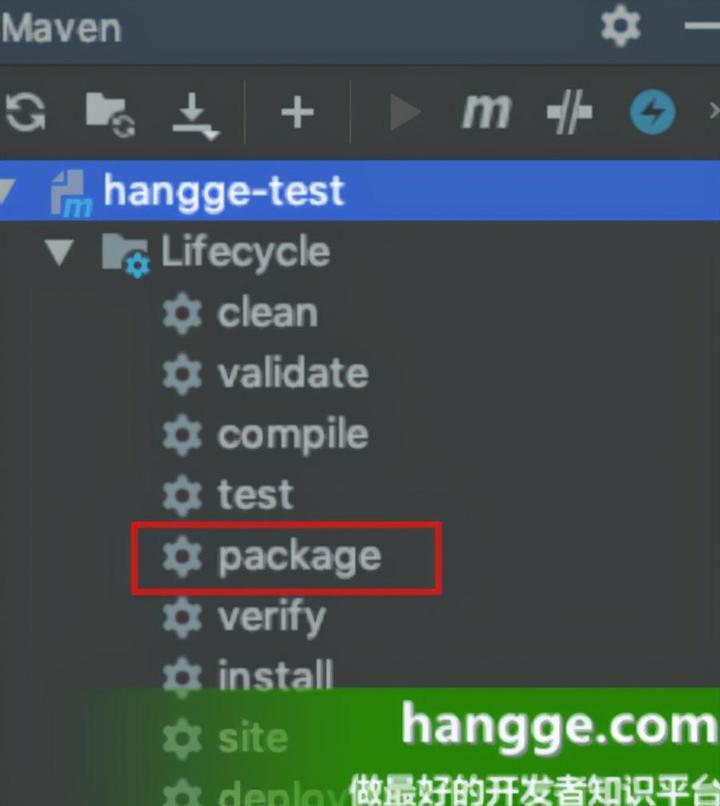
包后在 target 下便会生成一个名为 xxx.tar.gz 的压缩文件:
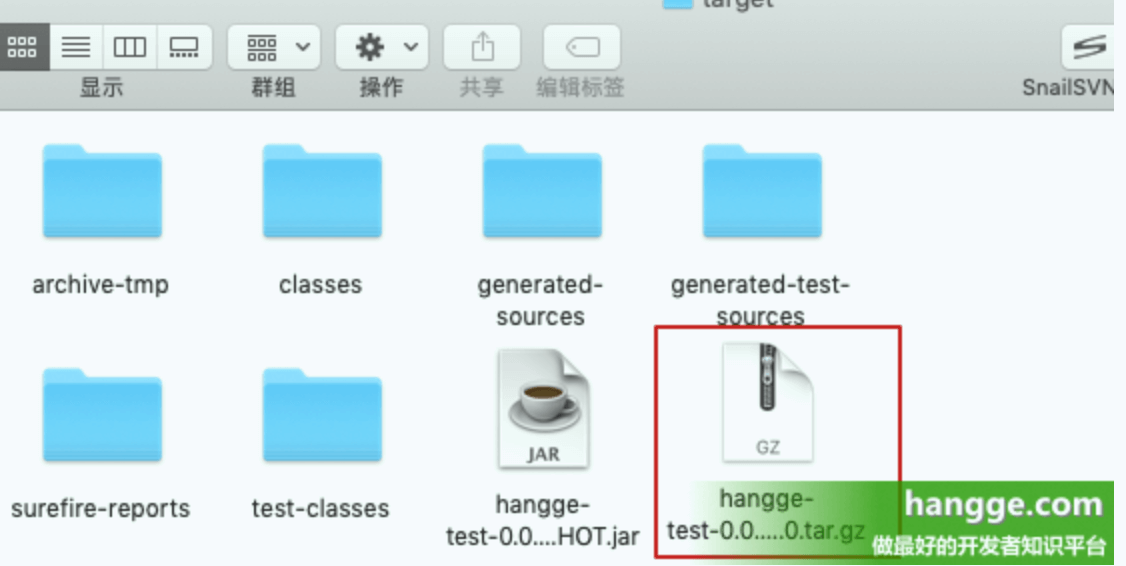
将这个压缩包解压后可以看到内部包含的目录如下:
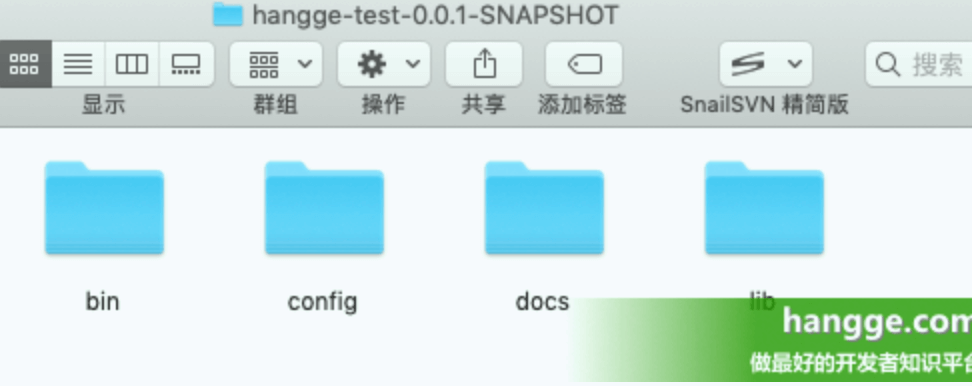
启动服务
上述打包文件解压后,在 bin 目录有如下几个启动文件
Linux、macOS 系统:执行 start.sh 启动服务,执行 stop.sh 停止服务。
Windows 系统:双击 start.bat 即可启动服务
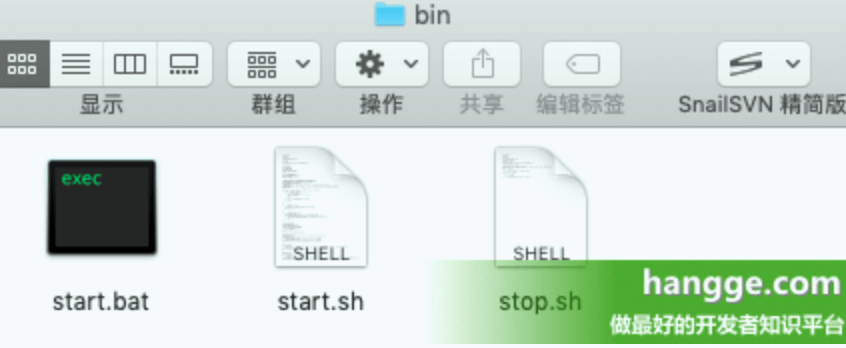
服务启动后,相应的日志文件会生成到 logs 目录下(logs 目录会自动创建)
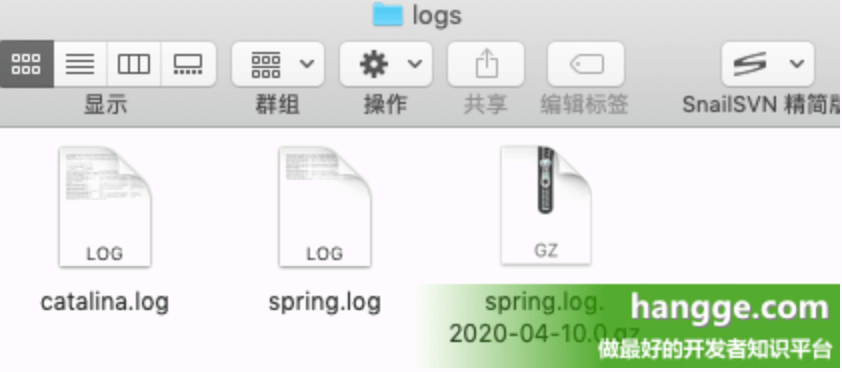
修改配置
修改 config 文件夹下面的配置文件,此处的配置文件是 application.properties。

这里我们将服务端口改成 9090。
server.port=9090重启服务,可以看到端口确实发生了变化,说明外部配置文件加载成功。

将项目与依赖分开打包
至此,上文中介绍的使用 assembly 对项目打包时,项目代码和项目所有的依赖文件会一起打成一个可执行的 jar 包。
如果项目的依赖包很多,那么这个文件就会非常大。每次发布版本如果都要上传这个整个的 jar 包,既浪费带宽也浪费时间。
下面介绍如何将项目的外部依赖跟自己的代码包分开打包,这样当项目修改后,只需要上传覆盖修改后的包即可。
修改配置
首先我们编辑 assembly.xml 配置文件。在前文的基础上新增第三方依赖设置,实现将第三方的 jar 包添加到压缩包里的 lib 目录:
<assembly> <!-- 必须写,否则打包时会有 assembly ID must be present and non-empty 错误 这个名字最终会追加到打包的名字的末尾,如项目的名字为 hangge-test-0.0.1-SNAPSHOT, 则最终生成的包名为 hangge-test-0.0.1-SNAPSHOT-bin.tar.gz --> <id>bin</id> <!-- 打包的类型,如果有N个,将会打N个类型的包 --> <formats> <format>tar.gz</format> <!--<format>zip</format>--> </formats> <includeBaseDirectory>true</includeBaseDirectory> <!--第三方依赖设置--> <dependencySets> <dependencySet> <!-- 不使用项目的artifact,第三方jar不要解压,打包进zip文件的lib目录 --> <useProjectArtifact>false</useProjectArtifact> <outputDirectory>lib</outputDirectory> <unpack>false</unpack> </dependencySet> </dependencySets> <!--文件设置--> <fileSets> <!-- 0755->即用户具有读/写/执行权限,组用户和其它用户具有读写权限; 0644->即用户具有读写权限,组用户和其它用户具有只读权限; --> <!-- 将src/main/assembly/bin目录下的所有文件输出到打包后的bin目录中 --> <fileSet> <directory>src/main/assembly/bin</directory> <outputDirectory>bin</outputDirectory> <fileMode>0755</fileMode> <!--如果是脚本,一定要改为unix.如果是在windows上面编码,会出现dos编写问题--> <lineEnding>unix</lineEnding> <filtered>true</filtered><!-- 是否进行属性替换 --> </fileSet> <!-- 将src/main/assembly/config目录下的所有文件输出到打包后的config目录中 --> <fileSet> <directory>src/main/assembly/config</directory> <outputDirectory>config</outputDirectory> <fileMode>0644</fileMode> </fileSet> <!-- 将src/main/resources下配置文件打包到config目录 --> <fileSet> <directory>src/main/resources</directory> <outputDirectory>/config</outputDirectory> <includes> <include>**/*.xml</include> <include>**/*.properties</include> <include>**/*.yml</include> </includes> <filtered>true</filtered><!-- 是否进行属性替换 --> </fileSet> <!-- 将项目启动jar打包到lib目录中 --> <fileSet> <directory>target</directory> <outputDirectory>lib</outputDirectory> <includes> <include>*.jar</include> </includes> </fileSet> <!-- 将项目说明文档打包到docs目录中 --> <fileSet> <directory>.</directory> <outputDirectory>docs</outputDirectory> <includes> <include>*.md</include> </includes> <fileMode>0644</fileMode> </fileSet> <fileSet> <directory>docs</directory> <outputDirectory>docs</outputDirectory> <fileMode>0644</fileMode> </fileSet> <fileSet> <directory>src/main/assembly/docs</directory> <outputDirectory>docs</outputDirectory> <fileMode>0644</fileMode> </fileSet> </fileSets> </assembly>接着编辑项目的 pom.xml 文件,先前使用的是 spring-boot-maven-plugin 来打包,这个插件会将项目所有的依赖打入项目 jar 包里面。我们将其替换为 maven-jar-plugin,并进行相关设置:
<build> <plugins> <!-- 指定启动类,将依赖打成外部jar包 --> <plugin> <groupId>org.apache.maven.plugins</groupId> <artifactId>maven-jar-plugin</artifactId> <configuration> <archive> <!-- 生成的jar中,不要包含pom.xml和pom.properties这两个文件 --> <addMavenDescriptor>false</addMavenDescriptor> <manifest> <!-- 是否要把第三方jar加入到类构建路径 --> <addClasspath>true</addClasspath> <!-- 外部依赖jar包的最终位置 --> <!-- 因为我们将第三方jar和本项目jar放在同一个目录下,这里就使用./ --> <classpathPrefix>./</classpathPrefix> <!-- 项目启动类 --> <mainClass>com.example.hanggetest.HanggeTestApplication</mainClass> </manifest> </archive> </configuration> </plugin> <plugin> <!--主要使用的是maven提供的assembly插件完成--> <artifactId>maven-assembly-plugin</artifactId> <version>3.1.1</version> <configuration> <descriptors> <!--具体的配置文件--> <descriptor>src/main/assembly/assembly.xml</descriptor> </descriptors> </configuration> <executions> <execution> <id>make-assembly</id> <!--绑定到maven操作类型上--> <phase>package</phase> <!--运行一次--> <goals> <goal>single</goal> </goals> </execution> </executions> </plugin> </plugins></build>打包测试
上面两个配置修改完毕后,我们重新对项目进行打包。将生成的压缩包解压后可以发现,lib 文件夹下项目 jar 包以及第三方 jar 都分开了,并且项目 jar 体积也十分小巧。

做梦都在改BUG
还未添加个人签名 2021-07-28 加入
公众号:该用户快成仙了











评论